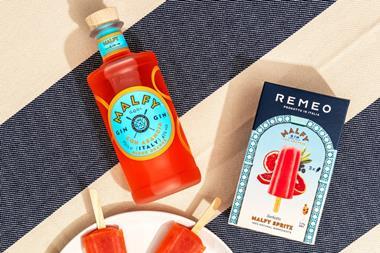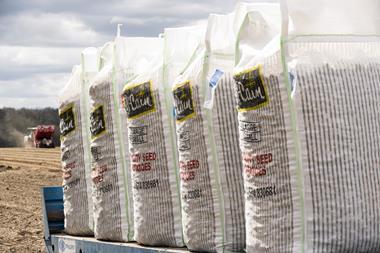Ice cream suppliers are coming up with increasingly clever ways to avoid passing commodity price rises onto consumers. Nick Hughes reports on the latest innovations in the sector
When sugar prices hit their highest level in 30 years in the second half of 2010, ice cream suppliers faced a conundrum; should they absorb the cost, increase the product prices or re-engineer their SKUs so that margins could be maintained and consumers not left to pick up the bill?
The solution was a mix of all three. Market leader Unilever was first to pass on the cost increase to consumers. The average headline price of Ben & Jerry's 500ml tubs topped £4 for the first time in November. Later the same month, rival Häagen-Dazs followed suit in a move hailed by some suppliers as a psychological breakthrough.
"Breaking the £4 barrier is a positive move for the market," says Neil Burchell, MD of Loseley Dairy Ice Cream. "Consumers need to understand that quality food commands a reasonable price."
Others, however, considered the price rise a red herring. "The headline price has moved, but after they'd moved it they were still promoting down to the same price point they had before it was a bit of a false dawn," says David Taylor, MD of Fredericks Dairies.
Taylor points out that it's not just the inflated price of sugar that has heaped pressure on ice cream suppliers in the past 12 months. "Everything's been high. Even cardboard boxes cost 45% more last year."
Mars Ice Cream says it, too, has had to recoup some of this cost "in order to maintain the viability of our business and grow" like Fredericks, it has done so partly through increasing prices. So it's hardly surprising that value sales of ice cream grew by 4.9% to £696m [Kantar 52w/e 28 November 2010] in 2010. But more encouragingly for the category, volume sales also rose by 3.2%, suggesting that suppliers' strategies are paying off.
So how have they persuaded consumers to pay more for ice cream yet buy more at the same time?
Rather than push through a percentage price increase across its entire portfolio, which includes Cadbury and Del Monte licensed products and the super-premium Antonio Federici brand, Fredericks has decided to rethink certain products.
"Some of our packs are smaller and some units smaller," says Taylor. "What we might do is take a unit out of a multipack or shrink each product a little bit. What we don't want is to be very top-end in price and then find consumers aren't willing to pay."
The re-engineering route is also being taken by former Morrisons ice cream buyer Mike Lewis, whose Good Feeling Solutions ice cream survived three range reviews in Morrisons before growing sales to £500,000 at retail last year, he says.
But inflationary pressures coupled with the increase in VAT meant Lewis's £2 price-marked three-litre packs of Banoffee Neapolitan ice cream were no longer financially viable, thanks to a combination of commodity costs, VAT and retailers' reluctance to increase prices on price-marked products. His solution was to invest £20,000 in repositioning it as a four-litre Big Value Pack, which he hopes will give better value.
Providing value was also behind R&R Ice Cream's launch of copycat Ben & Jerry's brand Loaded in Asda last March. The new exclusive own-label brand has already generated sales of £2.5m for Asda, says R&R Ice Cream marketing director Phil Griffin. R&R backed this up by introducing another premium tertiary brand, Spoony's, into Morrisons.
The price-flashed £2 pack comes in at almost half the price of Ben & Jerry's and represents "a much more affordable solution", says Griffin. While conceding that though "aggressive promotional tactics" Ben & Jerry's has widened the target market for super-premium ice cream, he insists price is a barrier for this sub-category.
Ben & Jerry's figures, however, suggest it's a surmountable barrier sales rose 5.8% to £68m [SymphonyIRI 52w/e 27 November 2010]. Age-old foes Ben & Jerry's and Häagen-Dazs were the star performers in the premium category, which rose in value by 3.4%, but saw volumes decline 1.5%.
Following a catastrophic 2009, with value sales falling 11.5%, Häagen-Dazs bounced back strongly in 2010, delivering sales growth of 15.3%. Last year, the brand added a chocolate, pralines and caramel variant to its chocolate portfolio, which had "an absolutely outstanding response" from consumers, according to Ed Culf, marketing director for brand owner General Mills. Culf says that on the back of a strong promotional plan and a national TV ad campaign, overall Häagen-Dazs brand penetration is the highest in a decade.
The other big hitter in 2010 was Magnum. Suppliers say its performance is one of the main reasons the chocolate sticks market has grown 15.7%. The launch of Magnum Gold was one of the key innovations in the ice cream category in 2010 and, boosted by a huge ad campaign featuring Benicio del Toro (see p53), the product has already recorded value sales of £5.1m since launch, according to Pete Harbour, category director for ice cream at Unilever.
Not that Unilever is resting on its laurels. Magnum Cocoa arrives in-store this month. The new range uses Rainforest Alliance-certified cocoa and its Ecuador Cocoa and Ghana Cocoa variants will benefit from a £3.5m campaign.
"Magnum is a real powerhouse brand," says Taylor. "We're the only challengers that can fight them in chocolate snacks because other brands come and go." However, on filled cones, which grew 10.2%, Taylor believes "honours were more even". Fredericks' Cadbury Caramel and Creme Egg cones did well," he says, "with the former the top-selling brand all year in Tesco."
Lollies were less successful, with value sales falling 4.4% to £58m. Griffin blames a downturn in innovation for the lacklustre performance of the segment. "Twister and Fab have been key to the underperformance of lollies as both brands benefited from extensions in 2009 that weren't repeated in 2010," he says. R&R plans to generate fresh growth in 2011 by launching Fab Apple & Blackcurrant.
Lack of innovation, however, was not the only culprit. Lollies' poor performance was also exacerbated by brand extension causing a blurring of the line between adult and kids' products, says Richard Hayhoe, marketing director of wholesaler P&H.
The strong performance of big brands such as Magnum and Ben & Jerry's has meant ice cream has had a "fairly strong year" in the convenience channel, according to Hayhoe, while of the supermarkets, Tesco showed the greatest increase in ice cream market share, followed by Waitrose.
Ice cream buyer Vanessa Stephenson says Waitrose has sustained growth over the past four years without significant range changes, although the premium segment has been added to with the launch of a new own-label offering. "Historically, we overtrade in premium ranges, so we have boosted this with the Seriously From Waitrose range," she says.
Top-end branded suppliers have also been evolving their product range. Loseley Dairy Ice Cream will overhaul its brand this month, with a new packaging design and improvements to flavour (see p50).
Kelly's of Cornwall launched a Chocolate Clotted Cream Ice Cream in September and this month is introducing a Blackcurrant Clotted Cream Ice Cream to Tesco and Waitrose. "We are taking a genuine Cornish ice cream and making it available to the wider public without compromising on its quality or taste," says Kelly's of Cornwall ice cream brand manager Nina Lumsden.
The transition of brands such as Kelly's from regional to national player should encourage niche brands looking to increase their penetration in supermarkets. While delis and farm shops give smaller brands a certain amount of exposure, becoming part of a supermarket range remains crucial to consumer engagement, according to Lawrence Rippon, national sales manager at New Forest Ice Cream.
Smaller producers including those in other sectors are making the most of the opportunities in ice cream. The Patchwork Traditional Food Company, better known for its pâtés, is launching a range of adult ice creams with grown-up flavours, including Calvados-soaked apple with Calvados Caramel Ripple. This month also sees Simply Ice Cream launch a nut range including a chilli chocolate almond variant.
But it's not all about ice cream. Frozen yoghurt is threatening to break into the mainstream. Fredericks is set to launch a Del Monte frozen yoghurt and smoothie bar this year to tap into the health trend.
Loseley's Burchell believes frozen yoghurt brands have faltered in the past because they are still marketed as 'ice cream' products, rather than in the yoghurt fixture.
The desire for healthier ice cream products remains a key consumer trend, according to Phil Webster, chief operating officer for Icefresh, the licensee for WeightWatchers ice desserts. As such, Icefresh's latest offering, WeightWatchers Waves, is being marketed as a healthy alternative to Wall's Viennetta, sales of which fell by 9.5% in the past year.
Promotions have always been a staple of the ice cream sector where "shopping the deals", as Taylor puts it, is the norm.
But with commodity price inflation showing no sign of abating, it may be that greater innovation and a collaborative effort by suppliers to increase prices are required if long-term margin retention is to be achieved.
Focus On Ice Cream
When sugar prices hit their highest level in 30 years in the second half of 2010, ice cream suppliers faced a conundrum; should they absorb the cost, increase the product prices or re-engineer their SKUs so that margins could be maintained and consumers not left to pick up the bill?
The solution was a mix of all three. Market leader Unilever was first to pass on the cost increase to consumers. The average headline price of Ben & Jerry's 500ml tubs topped £4 for the first time in November. Later the same month, rival Häagen-Dazs followed suit in a move hailed by some suppliers as a psychological breakthrough.
"Breaking the £4 barrier is a positive move for the market," says Neil Burchell, MD of Loseley Dairy Ice Cream. "Consumers need to understand that quality food commands a reasonable price."
Others, however, considered the price rise a red herring. "The headline price has moved, but after they'd moved it they were still promoting down to the same price point they had before it was a bit of a false dawn," says David Taylor, MD of Fredericks Dairies.
Taylor points out that it's not just the inflated price of sugar that has heaped pressure on ice cream suppliers in the past 12 months. "Everything's been high. Even cardboard boxes cost 45% more last year."
Mars Ice Cream says it, too, has had to recoup some of this cost "in order to maintain the viability of our business and grow" like Fredericks, it has done so partly through increasing prices. So it's hardly surprising that value sales of ice cream grew by 4.9% to £696m [Kantar 52w/e 28 November 2010] in 2010. But more encouragingly for the category, volume sales also rose by 3.2%, suggesting that suppliers' strategies are paying off.
So how have they persuaded consumers to pay more for ice cream yet buy more at the same time?
Rather than push through a percentage price increase across its entire portfolio, which includes Cadbury and Del Monte licensed products and the super-premium Antonio Federici brand, Fredericks has decided to rethink certain products.
"Some of our packs are smaller and some units smaller," says Taylor. "What we might do is take a unit out of a multipack or shrink each product a little bit. What we don't want is to be very top-end in price and then find consumers aren't willing to pay."
The re-engineering route is also being taken by former Morrisons ice cream buyer Mike Lewis, whose Good Feeling Solutions ice cream survived three range reviews in Morrisons before growing sales to £500,000 at retail last year, he says.
But inflationary pressures coupled with the increase in VAT meant Lewis's £2 price-marked three-litre packs of Banoffee Neapolitan ice cream were no longer financially viable, thanks to a combination of commodity costs, VAT and retailers' reluctance to increase prices on price-marked products. His solution was to invest £20,000 in repositioning it as a four-litre Big Value Pack, which he hopes will give better value.
Providing value was also behind R&R Ice Cream's launch of copycat Ben & Jerry's brand Loaded in Asda last March. The new exclusive own-label brand has already generated sales of £2.5m for Asda, says R&R Ice Cream marketing director Phil Griffin. R&R backed this up by introducing another premium tertiary brand, Spoony's, into Morrisons.
The price-flashed £2 pack comes in at almost half the price of Ben & Jerry's and represents "a much more affordable solution", says Griffin. While conceding that though "aggressive promotional tactics" Ben & Jerry's has widened the target market for super-premium ice cream, he insists price is a barrier for this sub-category.
Ben & Jerry's figures, however, suggest it's a surmountable barrier sales rose 5.8% to £68m [SymphonyIRI 52w/e 27 November 2010]. Age-old foes Ben & Jerry's and Häagen-Dazs were the star performers in the premium category, which rose in value by 3.4%, but saw volumes decline 1.5%.
Following a catastrophic 2009, with value sales falling 11.5%, Häagen-Dazs bounced back strongly in 2010, delivering sales growth of 15.3%. Last year, the brand added a chocolate, pralines and caramel variant to its chocolate portfolio, which had "an absolutely outstanding response" from consumers, according to Ed Culf, marketing director for brand owner General Mills. Culf says that on the back of a strong promotional plan and a national TV ad campaign, overall Häagen-Dazs brand penetration is the highest in a decade.
The other big hitter in 2010 was Magnum. Suppliers say its performance is one of the main reasons the chocolate sticks market has grown 15.7%. The launch of Magnum Gold was one of the key innovations in the ice cream category in 2010 and, boosted by a huge ad campaign featuring Benicio del Toro (see p53), the product has already recorded value sales of £5.1m since launch, according to Pete Harbour, category director for ice cream at Unilever.
Not that Unilever is resting on its laurels. Magnum Cocoa arrives in-store this month. The new range uses Rainforest Alliance-certified cocoa and its Ecuador Cocoa and Ghana Cocoa variants will benefit from a £3.5m campaign.
"Magnum is a real powerhouse brand," says Taylor. "We're the only challengers that can fight them in chocolate snacks because other brands come and go." However, on filled cones, which grew 10.2%, Taylor believes "honours were more even". Fredericks' Cadbury Caramel and Creme Egg cones did well," he says, "with the former the top-selling brand all year in Tesco."
Lollies were less successful, with value sales falling 4.4% to £58m. Griffin blames a downturn in innovation for the lacklustre performance of the segment. "Twister and Fab have been key to the underperformance of lollies as both brands benefited from extensions in 2009 that weren't repeated in 2010," he says. R&R plans to generate fresh growth in 2011 by launching Fab Apple & Blackcurrant.
Lack of innovation, however, was not the only culprit. Lollies' poor performance was also exacerbated by brand extension causing a blurring of the line between adult and kids' products, says Richard Hayhoe, marketing director of wholesaler P&H.
The strong performance of big brands such as Magnum and Ben & Jerry's has meant ice cream has had a "fairly strong year" in the convenience channel, according to Hayhoe, while of the supermarkets, Tesco showed the greatest increase in ice cream market share, followed by Waitrose.
Ice cream buyer Vanessa Stephenson says Waitrose has sustained growth over the past four years without significant range changes, although the premium segment has been added to with the launch of a new own-label offering. "Historically, we overtrade in premium ranges, so we have boosted this with the Seriously From Waitrose range," she says.
Top-end branded suppliers have also been evolving their product range. Loseley Dairy Ice Cream will overhaul its brand this month, with a new packaging design and improvements to flavour (see p50).
Kelly's of Cornwall launched a Chocolate Clotted Cream Ice Cream in September and this month is introducing a Blackcurrant Clotted Cream Ice Cream to Tesco and Waitrose. "We are taking a genuine Cornish ice cream and making it available to the wider public without compromising on its quality or taste," says Kelly's of Cornwall ice cream brand manager Nina Lumsden.
The transition of brands such as Kelly's from regional to national player should encourage niche brands looking to increase their penetration in supermarkets. While delis and farm shops give smaller brands a certain amount of exposure, becoming part of a supermarket range remains crucial to consumer engagement, according to Lawrence Rippon, national sales manager at New Forest Ice Cream.
Smaller producers including those in other sectors are making the most of the opportunities in ice cream. The Patchwork Traditional Food Company, better known for its pâtés, is launching a range of adult ice creams with grown-up flavours, including Calvados-soaked apple with Calvados Caramel Ripple. This month also sees Simply Ice Cream launch a nut range including a chilli chocolate almond variant.
But it's not all about ice cream. Frozen yoghurt is threatening to break into the mainstream. Fredericks is set to launch a Del Monte frozen yoghurt and smoothie bar this year to tap into the health trend.
Loseley's Burchell believes frozen yoghurt brands have faltered in the past because they are still marketed as 'ice cream' products, rather than in the yoghurt fixture.
The desire for healthier ice cream products remains a key consumer trend, according to Phil Webster, chief operating officer for Icefresh, the licensee for WeightWatchers ice desserts. As such, Icefresh's latest offering, WeightWatchers Waves, is being marketed as a healthy alternative to Wall's Viennetta, sales of which fell by 9.5% in the past year.
Promotions have always been a staple of the ice cream sector where "shopping the deals", as Taylor puts it, is the norm.
But with commodity price inflation showing no sign of abating, it may be that greater innovation and a collaborative effort by suppliers to increase prices are required if long-term margin retention is to be achieved.
Focus On Ice Cream









No comments yet